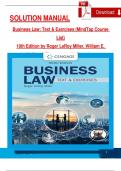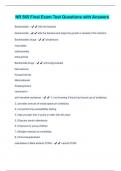Exam (elaborations)
Solution Manual For Business Law: Text & Exercises, 10th Edition by Roger LeRoy Miller, William E. Hollowell, Verified Chapters 1 - 43, Complete Newest Version
Solution Manual For Business Law: Text & Exercises, 10th Edition by Roger LeRoy Miller, William E. Hollowell, Verified Chapters 1 - 43, Complete Newest Version Solution Manual For Business Law: Text & Exercises, 10th Edition by Roger LeRoy Miller, William E. Hollowell, Verified Chapters 1 - 43, Com...
[Show more]




